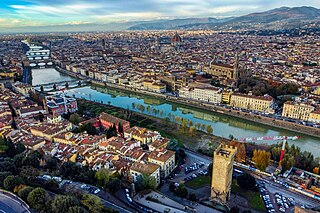
Florence is the capital city of the Italian region of Tuscany. It is also the most populated city in Tuscany, with 364,073 inhabitants in 2024, and 990,527 in its metropolitan area.
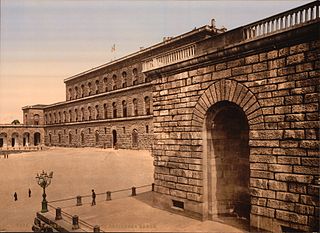
The Palazzo Pitti, in English sometimes called the Pitti Palace, is a vast, mainly Renaissance, palace in Florence, Italy. It is situated on the south side of the River Arno, a short distance from the Ponte Vecchio. The core of the present palazzo dates from 1458 and was originally the town residence of Luca Pitti, an ambitious Florentine banker.

Villa del Poggio Imperiale is a predominantly neoclassical former grand ducal villa in Arcetri, just to the south of Florence in Tuscany, Central Italy. Beginning as a villa of the Baroncelli of Florence, it was seized by the Medici, became the home of a Medici princess, and a lavish retreat for a Grand Duchess with imperial pretensions. Later given to Napoleon's sister, it was reclaimed by the hereditary rulers of Tuscany before being finally converted to a prestigious girls' school. During its long history, it has often been at the centre of Italy's turbulent history, and has been rebuilt and redesigned many times.

Palazzo Strozzi is a palace in Florence, Italy.

Palazzo Mozzi or Palazzo de' Mozzi is an early Renaissance palace, located at the end of the Piazza de' Mozzi that emerges from Ponte alle Grazie and leads straight to the palace where via San Niccolò becomes via de' Bardi in the Quartiere of Santo Spirito in the Oltrarno section of Florence, region of Tuscany, Italy. The 13th-century palace housed the gallery of the highly successful antiquarian Stefano Bardini, of which the remnants were left to the commune, where they assembled the Museo Bardini or Mozzi Bardini, displaying Florentine art and artifacts up to the early Renaissance. The gardens elaborated against the hillside behind the palace were added mainly by Bardini.

Giuseppe Zocchi was an Italian painter and printmaker active in Florence and best known for his vedute of the city.
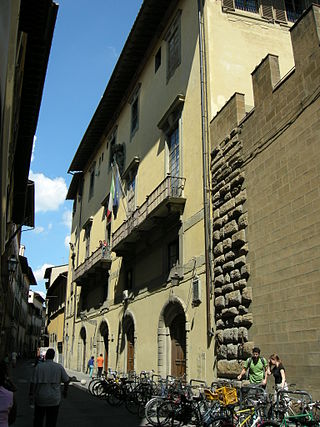
The Biblioteca Riccardiana is an Italian public library under the aegis of the Ministry of Culture, located inside the Palazzo Medici Riccardi at 10 Via de’ Ginori in Florence, in the neighborhood comprising the Mercato Centrale and the Basilica di San Lorenzo. Its main feature is preserving books collected by members of the Riccardi family and making them available in the very same rooms that were originally dedicated to that purpose. So, still today the library boasts the magnificent bookshelves, neatly carved and gilded, that create the atmosphere of a late-seventeenth-century patrician library, whose main features have all been kept intact.

Thomas Patch was an English painter, printmaker in etching, physiognomist and art historian. He made a living from painting views of Florence and Tivoli and appears to have sold a number of painted caricature groups to members of the Anglo-Florentine community and to young British men on the Grand Tour. The largest collection of his paintings and prints is in the Lewis Walpole Library in Farmington, Connecticut.

Sir Horace (Horatio) Mann, 1st Baronet KB, was a long-standing British resident and diplomat in Florence.
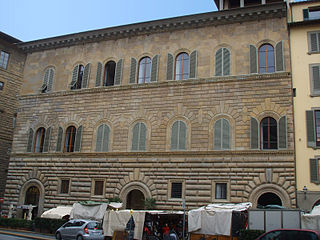
Palazzo Gondi is a palace in Florence, Italy, located a block from Piazza della Signoria. It was built in 1490 under design by Giuliano da Sangallo, who was inspired by other major works of stately buildings in the city, such as Palazzo Medici and Palazzo Strozzi. Among the elements borrowed from these earlier works are the cube-shape set around a central courtyard, the ashlar sloping on each of three floors, and the arched windows.

Palazzo Gherardi is a 15th-century building in the Santa croce quarter of Florence, Tuscany, in central Italy. Its main façade is on Via Ghibellina 88, while to the right it faces Via dei Pepi.
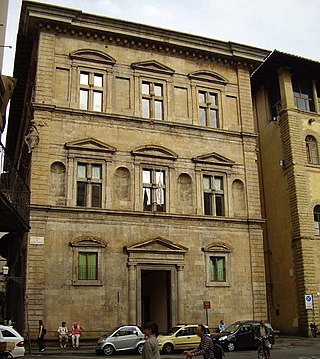
The Palazzo Bartolini Salimbeni is a High Renaissance-style palace located on Via de' Tornabuoni on Piazza Trinita in central Florence, Italy.

Palazzo Antinori is a Renaissance palace located at the north end of Via de' Tornabuoni, where it makes an odd corner with Via dei Pecori, Via del Trebbio, and converts into Via dei Rondinelli, in Florence, Italy.

Palazzo dello Strozzino is a Renaissance palace in Florence, Italy. The stone Renaissance facade is located on Piazza degli Strozzi, diagonal to the Southeast corner of the imposing Palazzo Strozzi. The Northern façade on Via dei Anselmi houses the entrance to the Cinema Odeon.
The following is a timeline of the history of the city of Florence, Tuscany, Italy.

The Palazzo di Bianca Cappello, originally belonging to Corbinelli family is a Renaissance-style palace located on Via Maggio #26 of the quarter of Oltrarno in Florence, region of Tuscany, Italy. It is notable for its facade decoration, and once housing Bianca Cappello, the mistress, then wife of the Grand-Duke Francesco I de' Medici
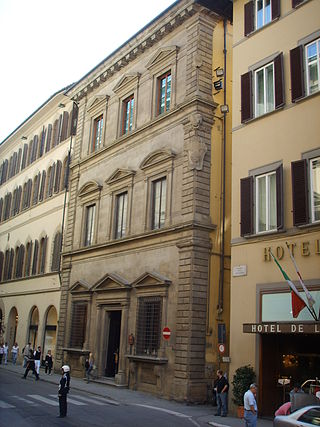
The Palazzo Larderel, once Tebalducci and Giacomini is a Renaissance-style palace, located on Via de' Tornabuoni number 19, corner via de' Giacomini 1, in the city of Florence, region of Tuscany, Italy.

The Palazzo Martelli was a residential palace, and since 2009, a civic museum displaying in situ the remains of the original family's valuable art collection, as well as its frescoed rooms. The palace is located on Via Ferdinando Zannetti 8 near the corner with Via Cerretani in central Florence, region of Tuscany, Italy.

The Palazzina Reale delle Cascine is a small Neoclassical palace sited on the Piazzale delle Cascine within the public park located along the north bank of the Arno river just north of central Florence, Italy. Built in the mid-18th century by the Grand Duke of Tuscany, in 2020 now houses part of the offices of the faculty of agricultural and forestry sciences of the University of Florence.

Palazzo Acciaiuoli, also known as Palazzo Usimbardi' or Usimbardi-Acciaiuoli, is located in Borgo Santi Apostoli in the historical centre of Florence. It incorporates the older Torre degli Acciaiuoli, formerly dei Buondelmonti, located at the corner of Chiasso delle Misure. Today it houses a hotel.





















